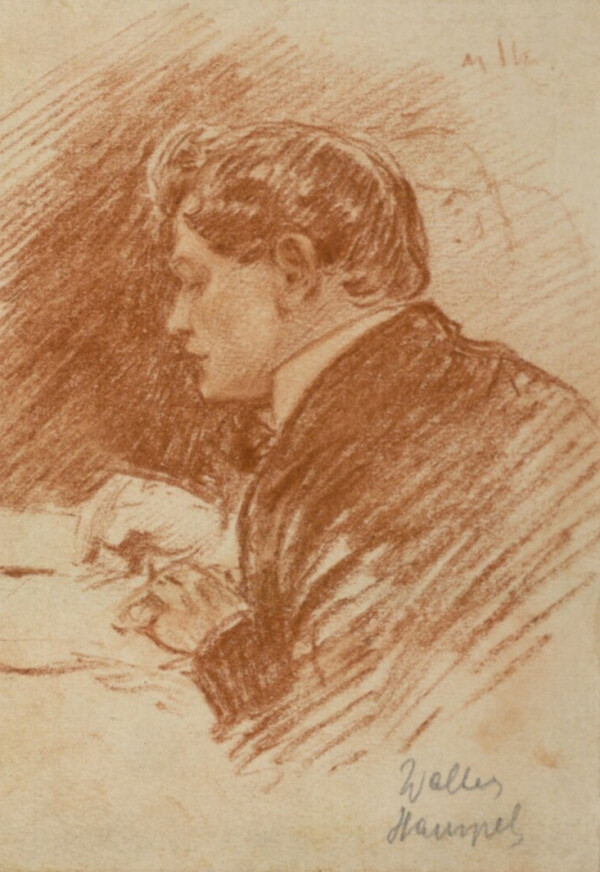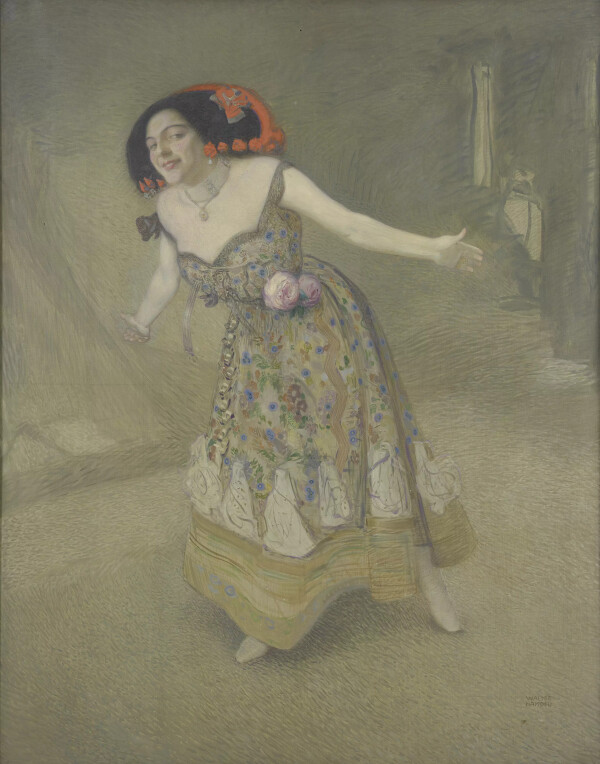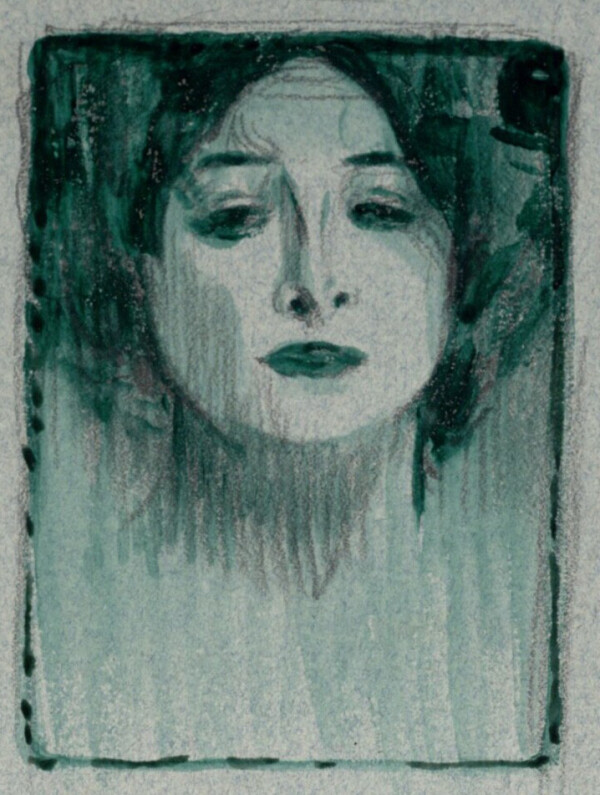Sigmund Walter Hampel

Sigmund Walter Hampel: Self-portrait, Hampel drawing, The Albertina Museum, Vienna
© The ALBERTINA Museum, Vienna

Sigmund Walter Hampel: Spanish Dancer (Portrait of Mlle E.), 1904, Wien Museum
© Wien Museum

Sigmund Walter Hampel: Woman's head from the front, The Albertina Museum, Vienna
© The ALBERTINA Museum, Vienna
Sigmund Walter Hampel was an Austrian genre and portrait painter, as well as a member of the Hagenbund. Among his close friends was Gustav Klimt, whom he purportedly helped find his garden studio in Hietzing. Like Klimt, Hampel, too, regularly spent his summer sojourns in the Salzkammergut region.
Sigmund Walter Hampel was born in 1867 in Vienna, the son of a painter. He initially studied “drawing and sculpting” for a year at the Staatsgewerbeschule [state trade school] in the 4th district of Vienna, before transferring in 1885 to the Vienna Academy of Fine Arts, where he attended the special classes headed by the painters Heinrich von Angeli, August Eisenmenger and Siegmund L’Allemand. In 1888, the young artist was expelled for opposing the academy’s prevalent teaching methods. After this, Hampel studied independently. Except for his participations in several Viennese exhibitions – his works featured, among other presentations, in the 1898 “Jubiläums-Kunstausstellung im Künstlerhaus” [Jubilee Art Exhibition at the Künstlerhaus] – Hampel’s further artistic career until the turn of the century is almost impossible to trace.
Hagenbund, Künstlerhaus and Late Successes
In 1900, Hampel became a member of the artists’ association Hagen (later: Hagenbund). Over the following 11 years, he presented mostly tempera paintings and watercolors, but also some examples of artisan craftwork in the association’s exhibitions. Three years later, Hampel participated in the “Louisiana Purchase Exposition” in the US city of St. Louis, where he was awarded the Grand Prize for his painting Transience. He subsequently celebrated successes and enjoyed recognition for his works in North and South America, as well as in Germany and Italy. In the 1910s, Hampel joined the Vienna Secession, but left the artists’ association Hagenbund in 1911.
In 1919, Hampel – who was still barely perceived as an artist, especially in Austria – was first honored with a special exhibition. As part of the “XXXIII. Ausstellung des Aquarellistenklubs” [33rd exhibition of the Club of Watercolorists], he presented a total of 53 works at the Vienna Künstlerhaus, which reflected his versatile artistic oeuvre. The newspaper Österreichische Illustrierte Zeitung commented on the special exhibition on 9 February 1919:
“The painter Walter Hampel suffers a typically Austrian artist’s fate. […] Hampel is likely the only Viennese painter of eminent importance who in necrotic, legendary Austria has not yet received any awards.”
Hampel’s participations in exhibitions are documented until the end of the 1920s. After that, he seems to have gradually retreated from public life. He moved to Nußdorf on the Attersee, where he had gotten married in 1903 and had spent many summers. Hampel died there in 1949.
Friendship with Gustav Klimt
The painter Gustav Klimt was among Hampel’s friends. An article from the newspaper Neues Wiener Journal, dated 7 April 1928, sheds light on their relationship. The contents of the article Der intime Klimt [The Intimate Klimt] were apparently founded on reports by Sigmund Walter Hampel, who talked about Klimt’s Hietzing studio and the beginnings of the group Siebener Club [Club of Seven]:
“At the time, seven young people joined forces with Klimt in a sort of club, without bylaws and regulations. An informal union of artists, which Klimt called his Club of Seven. Soon, it would be no more than a Club of Five […]. The five artists who were perhaps the first to go through thick and thin with Klimt were Kolo Moser, Olbrich, Urban, Orth and Hampel.”
The article further mentions their joint visits to the Tivoli, Klimt’s working and eating habits, the summer sojourns on the Attersee, as well as the empathy and antipathy the artist harbored for his fellow human beings.
Literature and sources
- Neues Wiener Journal, 07.04.1928, S. 8.
- Genossenschaft der bildenden Künstler Wiens (Hg.): Jubiläums-Kunstausstellung. II. Theil Fünfzig Jahre Oesterreichischer Malerei, Ausst.-Kat., Artists' House (Vienna), 20.10.1898–26.12.1898, Vienna 1898, S. 77.
- Österreichische Akademie der Wissenschaften (Hg.): Österreichisches Biographisches Lexikon 1815–1950, Band 2, Vienna 1994.
- Felix Czeike (Hg.): Historisches Lexikon Wien, Band 3, Vienna 1994, S. 40.
- Neues Wiener Journal, 15.07.1927, S. 9.
- Wiener Illustrierte Zeitung. Modernes Familieblatt, 09.02.1919, S. 344-345.
- Das kleine Blatt, 07.07.1942, S. 3.
- Die Zeit, 11.03.1907, S. 2.
- Der Tag, 04.02.1926, S. 7.
- Wiener Zeitung, 13.05.1906, S. 7.
- Andreas Beyer, Bénédicte Savoy, Wolf Tegethoff (Hg.): Allgemeines Künstler-Lexikon. Die bildenden Künstler aller Zeiten und Völker, Band LXIX, Berlin - New York 2010, S. 21.
- Ulrich Thieme, Fred C. Willis (Hg.): Allgemeines Lexikon der Bildenden Künstler von der Antike bis zur Gegenwart. Begründet von Ulrich Thieme und Felix Becker, Band XV, Leipzig 1922, S. 572.

